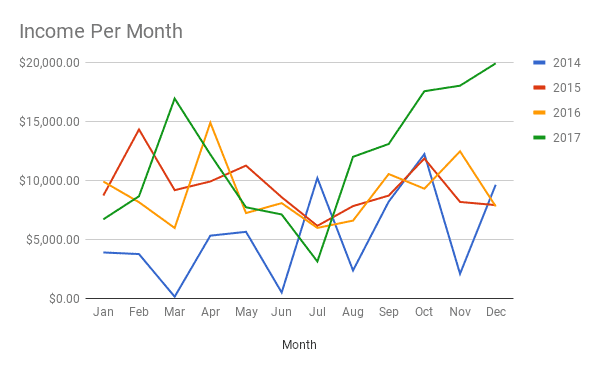Editor’s note: Sadly, there is a stigma in sharing your financial information with others. In a world that is seemingly driven by money, we’re quite ironically taught not to talk about how much we make. This school of thought can be quite dangerous and only leads to everyone being in the dark and struggling to assess where they are based on their personal goals, experience, and even where they stand with their current employer. These walls need to be broken down and the more we talk about this stuff, the more empowered we all are. Go out there and grab a coffee with a friend and talk about these things! You’ll be amazed at how informative and helpful these discussions can be. In the meantime, please enjoy this thoughtful, honest, and transparent Guest Post by Zack Lovatt as he breaks down his personal finances and what he has learned along the way.

Intro
I recently wrote a post on my site detailing my self-employed financials since I started freelancing back in 2010.
I wanted to take this opportunity to discuss in a bit more detail three things:
- Why I value this sort of financial transparency, and how it can help the industry;
- Why I value detailed bookkeeping as a freelancer;
- How the way I’ve recorded things has developed and evolved over the years.
On sharing income information
Over the years, there have been a few broad industry surveys asking the experience and income of motion designers around the world. While these have painted a broad picture of the income you could possibly earn, I feel that these results are too broad to be personally useful.
I mean, reading that “most motion designers earn between $30,000 and $90,000” is nice, but… how does it help me, where I live, doing what I want to do, at my level of experience? I believe that being able to see transparent, personal information from actual artists would be way more helpful for others in similar environments.
Additionally, if other people were open to sharing this same sort of thing, it would give even more artists an idea of what the industry is really like in their city, at their experience level. I’ve lived and freelanced in Toronto, Montreal and now Los Angeles. If I were to move somewhere else, I’d want to know roughly what I’d expect to earn there, and without this transparency, it’d be harder to build a realistic impression.
On ignoring the social stigma
All our lives, it seems as if we’ve been conditioned to keep our salaries private, for fear of committing a corporate faux-pas, of personal insecurity over a potentially lower salary, or of unease at the idea of earning more than our coworkers. This mentality sucks and keeps us in the dark, causing us to earn less than we’re worth across the board and removing a big part of our leverage during rate negotiations.
While you probably feel self-conscious asking a co-worker their salary (or another freelancer their day rate), have you ever stopped to think about why you feel this way? Is it because you’re worried that they’re better paid than you are? Are you worried you’re earning more than them? So what! In the first scenario, you now have more information about the possible market value of your skillset. In the latter, you’re in a position where you can educate somebody else, and hopefully, they can use that information to enter contract and salary negotiations more informed.
On publishing bookkeeping methods
Numbers aside, when I started out freelancing I had no idea how to keep track of things. Should I just have a list of invoices? What about expenses, do I need to track those? What can I claim as expenses, does my expensive morning latte on the way to the studio count? What about tax installment payments? And so on. I didn’t know what I had to keep track of, or the best way to do it.
I’m hoping that by sharing my own methods of data tracking, I can help others who are starting out and lost in a sea of mixed advice online about suggested bookkeeping practices.
Another benefit to publishing my bookkeeping sheets is that it opens the door for others to comment and provide feedback on my methods. Yeah, I’ve been tracking things this way for a few years, but I’m still learning, and resources for best practices are scarce; if somebody has found a better / more useful manner to organize info, I’d love to see how they do it so I can improve myself.
The Importance of Organization
After I submitted my tax return for my first year of full-time freelancing, I was immediately made aware that I somehow… forgot about income tax. I didn’t have anything set aside, and I had to come up with a lot of money to pay the tax man. This… was not good, and I had to borrow from my savings in order to pay back the difference over the next six months.
My second year of freelancing, I was a bit smarter! After doing some business’y research online, I learned that setting aside 30% of every invoice to cover income tax is a safe move, and it’s helpful to keep track of how much I should set aside at any point, in order to always know if my business savings account will cover my estimate amount owed. Sweet!
And then… I missed an income tax installment payment, and I couldn’t figure out how much I had paid or owed at that point in the year. This should have been easy to figure out — all I had to do was look at the payment receipts! Except… I didn’t have the receipts (oops), and I didn’t write down anywhere how much I had paid, or when. Plus, the government’s tax site was having issues that month, so I was out of luck and had to spend a day or two going through bank logs and reminder letters to figure out how much I needed to pay.
From there, in addition to tracking “30% of income” in my bookkeeping spreadsheet to estimate the amount of tax I owed, I started keeping track of when and how much my tax installments were paid in. This refinement would then make my “current tax owed” figure more accurate.
When you’re starting out, it’s easy to overlook any of a million things, and have to scramble after the fact to figure something out. Ask yourself: What do you owe, when, and how much? Did you set aside money for income tax, lest you be surprised with a $20k tax bill come April that you’re unprepared for? Your country may require you to collect and remit sales tax. (As a Canadian, I needed to!) How much did you collect, remit, and still owe? Not only that but how much sales tax did you pay out to freelancers or expenses (as you can claim sales tax paid to earn tax credits)?
On being aware

Staying organized in your business is the best and only way to grasp the big-picture status of your freelancing, without any sort of rose-colored glasses or confusion about where things are. Just because you’ve been working 60-hour weeks doesn’t mean the business is doing well or has earned a profit in the year.
When you’re going into your bookkeeping and updating your income and expense sheets every week, you’re much more conscious of how your business is doing, and the real cost of things. It’s easy to go online and spend a bunch of money on a new computer, or office speakers, or the hottest AE script (?), but having the visual knowledge that your expenses have exceeded your profits for a month (or, that your last invoice didn’t even cover that new computer, after setting aside money for taxes!) makes you very aware of the living state of your work.
When you go to file taxes, you’ve already done most of the work your accountant will charge you for, you’ve already categorized your expenses (so you know where you’re spending the most), and you’re always conscious of whether you’re earning enough to hit your goals.
Finding Trends
So! You’ve got all this information on how much money you’ve earned in a month, you know when the invoices were paid, what your expenses were, what type of expense they are, and when the purchases were made. For bookkeeping purposes, that’s all you need! Job done, right? Well, yes, but wait! There’s more…
On the slow seasons

Google Sheets is really good at taking any sort of data and turning it into a graph. It’s really easy. You select some cells, hit a button, and BAM you’ve got a chart. You can see how much you made per month. Awesome!
While this sort of information is fairly straightforward, the real power lies in understanding what it tells you. It can be hard to draw big-picture insight from numbers alone, but when you’re looking at charts, you can easily visualize the state of your freelance business. You can use what you’re seeing to draw conclusions and leverage those to change how you operate your business. Maybe some of those conclusions are inaccurate, but if you start to see the same patterns over time you can begin to predict future performance.
For example, if you see that summers are always the slowest time of the year for you, you can use this information to benefit you. If you want to raise that dip, you can try to use late spring to spend more time lining up either longer-term work or new clients for those slow Summer months. Alternatively, instead of worrying about having less income and lose sleep, you could conclude that this is perhaps just how the industry flows in your city at this time of year. Lean into the opportunity, spend that time on personal wellness (vacations, exercising more, exploring your hobbies) or shift your schedule to learn new skills. It’s the perfect time to learn that plugin you bought on Black Friday, or check out the latest 3d tutorials, or whatever it is that you’re looking to learn.
On finding a real hourly rate

Beyond the timing of payments, if you look at the number of hours spent on each project, you’ll be able to see your effective hourly rate. Maybe you’re using value-based billing, or you agreed to a fixed price, or you had to work unpaid overtime when working on-site at a client’s studio. If you keep track of how many hours you actually spent working vs total billed hours, you’ll be more informed when the next project comes in.
If a regular client always ends up asking you to stay late at the studio, you’re probably happy to oblige — the work is good, the client is great, and it’s just a few hours, right? But when you look back at the numbers and see that you’re earning 25% less on these invoices than any other, you can choose to ask for a higher rate, or perhaps turn down one of these bookings in favor of something with fewer hours and higher income.
Conclusion
Wrapping up, I feel that there’s a lot to be gained by the industry as a whole if more people are willing to share more information about how their business is doing. It gives everyone more power during negotiations and helps with reducing pay gaps and inequality in payroll.
Furthermore, keeping track of how your own business is doing gives you much more power and awareness, reduces the probability of making financial mistakes and grants you more insight into how freelancing is really going for you. My method isn’t perfect, nor will it work for everyone; but it doesn’t need to. You’ll certainly find what works best for you. Mine has evolved with my needs over the years, and I’m sure it’ll continue to grow with my experience.
Now it’s your turn. What are your thoughts on this sort of transparency? What are your numbers like?




